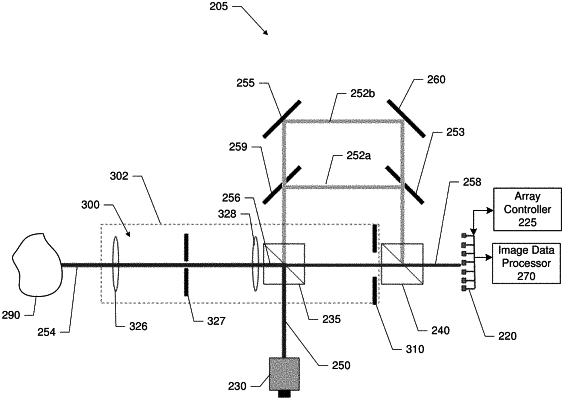| CPC G03H 1/2205 (2013.01) [G02B 13/22 (2013.01); G02B 27/1006 (2013.01); G03H 1/0443 (2013.01); G03H 2001/0463 (2013.01); G03H 2001/2207 (2013.01); G03H 2222/20 (2013.01); G03H 2222/45 (2013.01); G03H 2226/02 (2013.01)] | 18 Claims |

|
1. A holographic imaging system configured to detect changes in biologic tissue indicative of neural or physiological activity in the tissue, the holographic imaging system comprising:
an optical source configured to output a source beam;
a splitter configured to split the source beam into a reference beam and an object beam, the object beam being incident on a target to form a scattered object beam;
a combiner configured to combine the scattered object beam with the reference beam to form an interference beam;
an imaging array configured to receive the interference beam and generate frames of raw holographic data based on measurements of the interference beam over time;
a reference beam splitter configured to split a time delayed reference beam from the reference beam, wherein the reference beam is incident on the combiner at a first angle and the interference beam leaving the combiner is incident on the imaging array at a second angle; and
an optical element configured to direct the time delayed reference beam at the combiner at a third angle that is different than the first angle of the reference beam to cause a time delayed interference beam leaving the combiner to be incident on the imaging array at a fourth angle that is different than the second angle of the interference beam, wherein the imaging array is configured to receive the interference beam associated with the reference beam at a first time and a time delayed interference beam associated with the time delayed reference beam at a second time; and
an image data processor configured to:
receive the frames of raw holographic data from the imaging array;
separate the raw holographic data corresponding to each frame of the frames of raw holographic data captured as a single frame capture by the imaging array into a first effective frame of raw holographic data and a second effective frame of raw holographic data based on the second angle of the interference beam on the imaging array and the fourth angle of the time delayed interference beam on the imaging array, wherein the first effective frame and the second effective frame are ones of a plurality of effective frames of raw holographic data generated via the separating;
remove data components within the effective frames of raw holographic data that are indicative of moving particles within the biologic tissue having a motion frequency that is less than a movement frequency threshold to form conditioned raw holographic data; and
generate an image based on the conditioned raw holographic data.
|